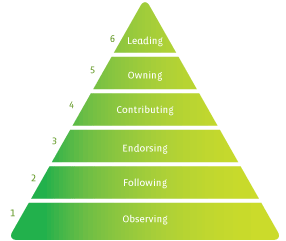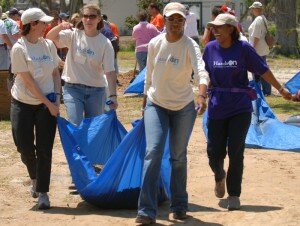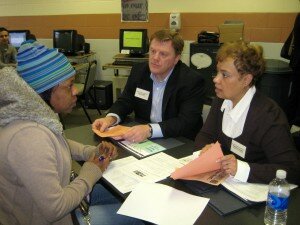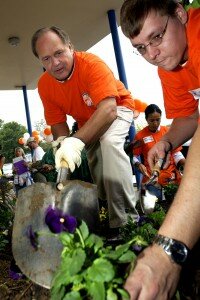Ready…Set…Volunteer! This Sunday, February 5 is every American’s favorite day SUPER BOWL SUNDAY!!! Woohoo hear the crowds roar with  excitement! Who can resist watching funny commercials, seeing Madonna perform for the halftime show, seeing your favorite teams fight to the death, eating yummy food, and just participating in some good ol’ American fun!
excitement! Who can resist watching funny commercials, seeing Madonna perform for the halftime show, seeing your favorite teams fight to the death, eating yummy food, and just participating in some good ol’ American fun!
Here at HandsOn Network we are not only excited about the opportunity to hang out with friends and family while watching the greatest sports event of the year, but also for the opportunity to make a party out of a service event. What do you mean, you may be wondering to yourself? You got me all hyped up about a day of good ol’ day of American fun to then have the obligation to volunteer?
Wrong, turning your Super Bowl party into a service project is just as easy as predicting that you will see a million Doritos commercials on Sunday.
So how does this happen, how can I make my day of fun into a day of service as well? Easy, we have a list full of simple fun ways to make service a good call rather than a penalty to your excitement! Come on put that plate of chicken wings down and check out our service ideas below:
-
Make a substitution: So we all know that eating fatty American foods is just part of the Super Bowl tradition. While this is still an option to your event planning, why not add a little twist to the mix? Ask guests to bring a couple canned foods to your party that can be donated to your local food bank. It is a win-win situation unlike Billy Cundiff, of the Baltimore Ravens who missed the
winning field goalgame tying which would have knocked the Patriots out of Super Bowl contention. You win because you get to hang out with your friends while serving your community. Your local food bank wins because their shelves are stocked thanks to your wonderful donation! -
Team up: Add a little competition to your Super Bowl event. Compete with your neighbors (I mean it would not be the Super Bowl without a little competition, right?). Tell your neighbors about your idea to fight hunger for the Super Bowl and encourage them to do the same.
 Compose cheers, make signs, wear uniforms, etc. Whoever collects the most food gets the trophy. Competition adds a fun aspect to the service initiative because it keeps players’ adrenaline going! Isn’t that why the most of us watch the Super Bowl in the first place?
Compose cheers, make signs, wear uniforms, etc. Whoever collects the most food gets the trophy. Competition adds a fun aspect to the service initiative because it keeps players’ adrenaline going! Isn’t that why the most of us watch the Super Bowl in the first place?
- Draft: While you and your community is in the midst of this great hunger competition make a pact to fight hunger year round. With all the fun you are going to have it will not be hard to recruit people for your hunger team! You can make this happen through making a donation calendar, assigning a bin to be stored in a local area for donations, writing up a schedule to define who will take donations to the food bank each month, etc. Just remember communication is key to any successful team!
- Celebrate your victory: After all this fierce hunger game play, you and your teammates are allowed to take pleasure in your hard work. Enjoy the game, eat great food, have fun with your friends. What is the point of competition if you cannot celebrate it at the end?
After the holiday hype, food banks tend to run low on supplies. By making your Sunday Super Bowl party into a “Fight Hunger” service project you will help this reality become a fact of the past!

Organizations such as Souper Bowl of Caring are great ways that you can get your event started, as well. Souper Bowl of Caring is a youth driven organization that actively fights hunger around Super Bowl time. They go around in their communities collecting money and food donations in a soup pan. They will donate 100% of their proceeds to a local hunger relief organization of their choice. Last year, more than $9.5 million dollars worth of donations were collected by youth volunteers across the nation. Learn more by visiting Souper Bowl of Caring’s website where you can register to participate and find many resources to get involved in this great cause.
Still hungry for more? Our friends at generationOn also have a huge resource database for kids, parents, and teachers to get involved in the hunger fight!
So put your game face on this Sunday and make the play to fight hunger for your community members! You will reap the benefits and go home with the gold thanks to your pledge to end hunger in 2012!


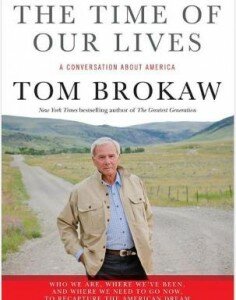
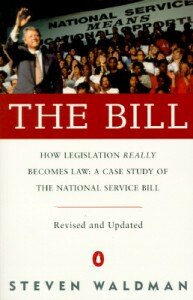



 IN WITNESS WHEREOF, I have hereunto set my hand this twenty-first day of December, in the year of our Lord two thousand ten, and of the Independence of the United States of America the two hundred and thirty-fifth.
IN WITNESS WHEREOF, I have hereunto set my hand this twenty-first day of December, in the year of our Lord two thousand ten, and of the Independence of the United States of America the two hundred and thirty-fifth. Fortunately, there is now a big push to help communities across the country tap the incredible skills so many volunteers have to offer. In 2008 the
Fortunately, there is now a big push to help communities across the country tap the incredible skills so many volunteers have to offer. In 2008 the  Be flexible and show respect. It would be great if people with needed skills were willing to devote themselves to one charity, or solely to volunteerism, but they probably need to spend the majority of their time working on paid projects or looking for work. Give the volunteers specific tasks and short-term projects that require only a few hours per day or a few months of their time and make sure their important contribution is recognized. The obvious way to do this would be individual praise, but write-ups on the charity’s Web site or Facebook page or in an electronic newsletter to supporters can show appreciation. Let volunteers see how their work helps move the organization forward. Those “rewards” aid in continued motivation and retention.
Be flexible and show respect. It would be great if people with needed skills were willing to devote themselves to one charity, or solely to volunteerism, but they probably need to spend the majority of their time working on paid projects or looking for work. Give the volunteers specific tasks and short-term projects that require only a few hours per day or a few months of their time and make sure their important contribution is recognized. The obvious way to do this would be individual praise, but write-ups on the charity’s Web site or Facebook page or in an electronic newsletter to supporters can show appreciation. Let volunteers see how their work helps move the organization forward. Those “rewards” aid in continued motivation and retention.



 unteering opportunities!
unteering opportunities!


